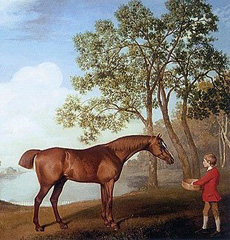AQUILA

...if I have always worked honestly, my horse will carry me to the end of the world. E.F. Seidler |
News - Arthur Kottas Clinic, 15th August, Hennef |
| Back to Current News |
Don't try to work on collection in the first year of training. Use working tempo - walk, trot and canter - when you first put a rider on the horse to allow the horse to find its balance again. In the second year, work on the 1st degree of collection. The seat is the key for security and success. You need to be able to sit independently in the saddle - independent of the rein. Even in the Spanish Riding School in Vienna, there were riders that could never develop the correct seat. Get the horse to stretch into the hand - bring the horse into the hand. We want an active hind quarter over a springy back to the hand. Don't brake with the hand and drive with the legs at the same time. One of our most important goals is to train horses that are safe - that have no vices such as biting, or kicking, or striking. Correct training is important - it is not enough to just read about it, we need to be able to demonstrate it. The first horse was Picaro, a 5 year old PRE stallion, under saddle for approximately 6 months. Ridden in a Baucher bit. The horse is not quiet in the mouth. The rider wants to work on achieving contact. Accepting the bit can be a bit difficult, therefore, start with upwards and forwards. If the horse curls behind the vertical, lengthen the reins and drive him forward lightly. If you have the correct length of reins, you can be quiet with your hands. Then press on the reins - don't pull back. If your shoulders are back, your stomach is in - this is not a driving seat. Horses shouldn't need to stop when they need to defecate; they can't do this in a test. Make sure that your circles are circles, not ovals. The Baucher bit seems to be a bit thin. Also, it is a driving bit, and has a light lever effect. This may be making the acceptance of the bit more difficult. If AK has a horse that doesn't want to accept the bit, he will longe with side reins correctly adjusted. Sit up and out of your hips. Don't sit on the horse, sit in the horse. Reins with keepers might help this rider figure out the correct rein length more easily. Your shoulders should be aligned with the horse's shoulders, therefore on a circle, your inner shoulder will be back a small amount. The second horse was a Lippizaner stallion, born in 1994, licenced but has never served a mare. Purchased in Lippica. Working at M & S levels (in lessons). The owner purchased him in 1998. Keep the reins the same length, even. Bring the horse's head up - put your hands up for a short time, but not back (note: this was a very subtle movement, not as obvious as the Philippe Karl method - honestly, I couldn't see that the hand movement had any effect on the head position most times). Ride a lot of circles to get him correct. Then ride a lot of lateral movements to correct him more. The third horse was a 14 year old competition warmblood mare, in hand work. The mare is not very relaxed in her work. Through tense training and riding, she has developed very strong under neck muscles. In hand work with young horses brings the horse into balance etc without the weight of the rider. Also, we try to bring the hind legs under. It is like 'baby gymnastics'. In hand - either stand far enough behind the horse so that you can't be kicked, or close at the flank so that you can't be kicked. Safety is paramount. AK uses a girth over the saddle. to run the reins through. If the reins are too long, they are no good (they catch on things, or a horse's leg can step over them). You need to have a goal! You should differentiate between in hand work, and work on the long rein. Normally, we set the reins through a ring so that the reins go through (the roller) at the level of the lower hind quarter. But, if the horse puts its head down too low (or behind the vertical), then put the reins through a higher ring on the roller. Start lower, and put through a higher ring if you need to. Next horse: The stirrups need to be short enough that you can go into a light seat easily. You need a bit of bend in your leg.
|
. |
. |